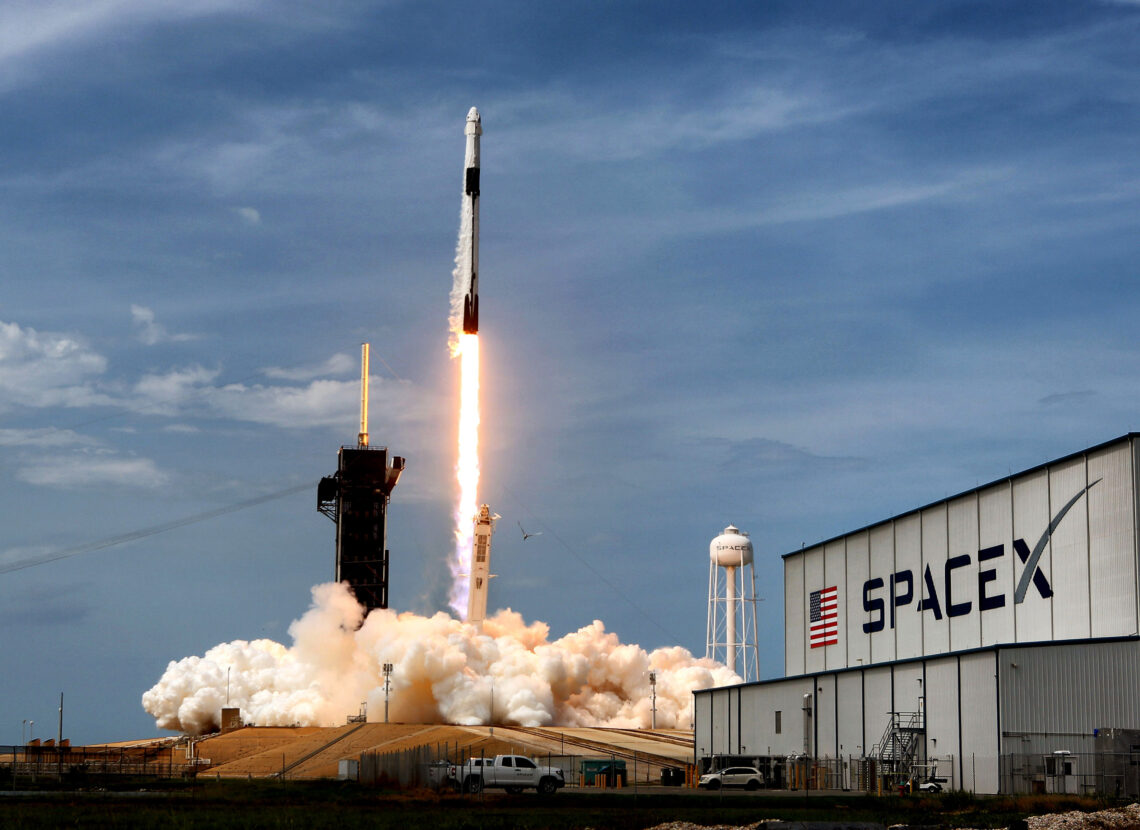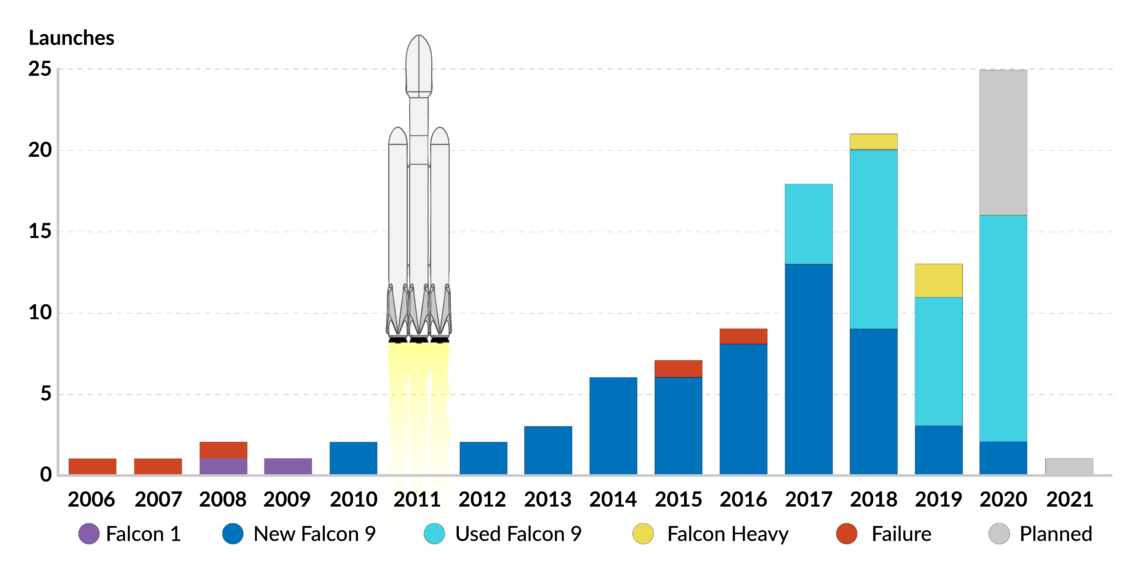The second space race
The success of a private company teaming up with NASA to launch astronauts past Earth’s atmosphere shows how far technology has come since the first space race in the 1950s and 1960s. With such advancements at hand, a second space race is in the making.

In a nutshell
- Technological advancements have increased access to space
- More countries will gain the ability to project power into space
- Public-private partnerships will be a key space business model
The first space race heated up in the late 1950s and 1960s, between the world’s two superpowers, the United States and the Soviet Union. Since then, several more countries have gained the ability to conduct space activities. Combined with the latest accomplishments among private companies like Elon Musk’s SpaceX, a second international space race is emerging that will likely shift the current paradigm about who has access to space.
In recent years, technology and commercial opportunities have paved the way for groundbreaking developments in space exploration. Advancements in data collection and processing, digital technologies, supercomputing and artificial intelligence have enabled countries and businesses around the world to pursue the commercialization of space.
One of the first commercial leaps into space was the 1962 launch of the Telstar communications satellite, funded by telecom giant AT&T. Thousands of privately funded satellites for navigation, imagery, weather and communication purposes have been sent into orbit since.
U.S. citizens can claim property rights on resources mined from bodies in outer space.
Some of the more recent extraterrestrial business ideas relate to space tourism. Aerospace companies such as Blue Origin (founded by Amazon CEO Jeff Bezos) and Virgin Galactic (founded by business magnate Richard Branson) are developing commercial spacecraft to provide such services. Both companies plan to launch flights in 2021, kickstarting the second space race.
Some firms are working to exploit raw materials in space. Firms like Planetary Resources and Deep Space Industries were established with the hope of mining minerals from asteroids and comets. Though neither company succeeded, their efforts paved the way for others and led to the creation of the U.S. Commercial Space Launch Competitiveness Act, which allows U.S. citizens and firms to claim property rights on resources mined from bodies in outer space.
With the vast commercial opportunities potentially available in space, nations and businesses worldwide are becoming increasingly interested in research, resource extraction and investment there.
Privatization and partnership
For a long time, government space agencies worked solely with state-funded aerospace contractors such as Boeing, because investors had traditionally considered the commercial opportunities in space a costly, high-risk affair. This attitude is changing as new private entities reinvigorate the space industry.
One of the firms most responsible for this shift is SpaceX. In mid-2020 it sent NASA astronauts Bob Behnken and Douglas Hurley to the International Space Station (ISS). It was the first time in history that a private company had performed a launch in partnership with the U.S. space agency. In August 2020, aerospace company Sierra Nevada Corporation announced that it aims to complete its first operational space plane by March 2021. The craft is slated to deliver cargo to the ISS.
Facts & figures

In September 2020, NASA announced that it was looking for companies to make space-mining trips and is planning to conduct operations with astronauts employed by private firms. Such partnerships look likely to become a key business model for space projects in the years to come.
Companies are also going solo – instead of partnering with a government agency – in the pursuit of commercializing space services. In September 2020, Amazon hired former White House official Peter Marquez to lead its newly established space policy department. Virgin Galactic’s share price has risen sharply since it went public on the New York Stock Exchange in October 2019, as investors flock to partake in the pioneering business model.
The world’s top three space venture capital funds, Space Angels, Seraphim Capital and Noosphere Ventures, all say that the capitalization of the space market is growing rapidly. According to forecasts by American investment bank Morgan Stanley, the global space industry could generate revenue of more than $1 trillion by 2040. On the policy side, government leaders are open to private investment in space ventures. Recently, a White House memo released in August 2020 showed that the administration of President Donald Trump wants to encourage economic development in space. Private companies are altering the dynamics of the industry. In the long term, these organizations are likely to establish a foothold in space independently of national space agencies.
Emerging powers
The rapid advancement of technology and commercialization has sped up international competition. As public-private partnerships open up scientific and business opportunities, the number of space industry competitors will grow, with more and more firms coming from somewhere other than the U.S. or Russia.
The European Union is one of several actors trying to establish dominance in aerospace. The European Space Agency is calibrating its long-term space goals and recently received a record budget of 14.4 billion euros to be spent over the next five years. Furthermore, European Commission President Ursula von der Leyen has emphasized the importance of the EU’s space ambitions by creating the Directorate-General for Defence Industry and Space (DG DEFIS), an independent department dedicated solely to the defense and space policies.
European Space Agency recently received a record budget of 14.4 billion euros.
During the summer of 2020, European Internal Market Commissioner Thierry Breton touted the EU’s space endeavors and said the bloc would allocate 16 billion euros for missions to the Moon, Mars and some asteroids. Weeks later, the Commission’s draft budget for space was slashed, meaning the EU will have to collaborate with other partners to conduct projects.
Countries like India and the United Arab Emirates are also taking the giant leap into space, hoping to become powers in the arena. The Chandrayaan-3 is a lunar exploration mission by the Indian Space Research Organization that is expected to launch in the first half of 2021. If India succeeds, it will become the fourth country to make a soft landing on the moon. Additionally, with its Gaganyaan mission, India aims to send a three-member crew to space for seven days in 2022.
The first space race: important dates
| October 4, 1957 | First artificial satellite, Sputnik 1 (USSR) |
| November 3, 1957 | First dog in orbit (USSR) |
| January 2, 1959 | First lunar spacecraft (USSR) |
| January 31, 1961 | First primate (chimpanzee) in space (U.S.) |
| April 12, 1961 | Yuri Gagarin becomes first human in space, first orbital flight of a manned vehicle (USSR) |
| May 5, 1961 | First pilot-controlled space flight (U.S.) |
| October 12, 1964 | First multiperson crew (USSR) |
| December 18, 1965 | 14-day human spaceflight record (U.S.) |
| December 21, 1968 | First human-crewed spaceflight to, and orbit of, the Moon (U.S.) |
| July 20, 1969 | First humans on the Moon, first space launch from another celestial body (U.S.) |
The UAE joined the second space race in 2019 when it adopted its first space strategy, passed its first space law and sent its first astronaut to the ISS. In July 2020, the UAE launched a spacecraft that is set to arrive on Mars in February 2021. The country has also been eyeing advancements in space tourism and mining.
China is gearing up for competition in space. From satellites to rockets and lunar projects, Beijing is moving fast. With the Chang’e 5 mission, set to launch in November 2020, China aims to become the third nation to bring back geologic samples from the Moon after the U.S. and Soviet Union. The mission will be a trial for future manned landings on the Moon and a challenge to American lunar dominance. China’s advancements in space have elevated the tension between Washington and Beijing. They have also prompted U.S. President Donald Trump to task NASA with sending U.S. astronauts back to the Moon by 2024 under the Artemis program.
Militarization
Outer space will also likely become more relevant to national security policies. For example, President Trump considers it insufficient for the U.S. to merely have a presence in space; he wants it to be dominant. That standpoint has led to friction between global powers.
The U.S. suspects that China is using its national space strategy to attract partners for its Belt and Road Initiative, thereby deepening the reliance on China’s systems and services. The China National Space Administration (CNSA) will soon start building a space station to be operational by 2023, while, in contrast, the ISS will be decommissioned in a few years. The development has prompted Washington to focus on outer space’s national security implications more than ever before.
The U.S. says China and Russia are the most serious threats to its space operations.
Recently, the U.S. has reiterated its doubts about China’s and Russia’s true intentions when it comes to their satellite activities. The U.S.’s 2020 Defense Space Strategy lists China and Russia as “the most immediate and serious threats” to American space operations due to their military doctrines, which extend to space, and the nature of the technology they have deployed. According to the document, China and Russia have each weaponized space to reduce U.S. military effectiveness and challenge freedom of operation in space. A Pentagon report released in September 2020 accuses China of developing missiles and electronic weapons that could target satellites in orbit.
The U.S. has also released details about an alleged Russian anti-satellite weapons test. Meanwhile, Russian President Vladimir Putin has accused Washington of accelerating the creation of its space force to preserve strategic supremacy.
The U.S., Russia, China and 107 other countries are parties to the 1967 Outer Space Treaty, which limits the use of space to peaceful purposes. Considering the technological advancements and the recent friction, the agreement likely offers an insufficient guarantee against clashes. Though the current tension between the superpowers will not escalate into a military conflict anytime soon, nations will continue to pursue their own national security strategies in space.
On one hand, the increasing security concerns may reduce the private sector’s willingness to further engage and invest in outer space. On the other, nations’ unilateral pursuit of security matters might encourage the establishment of a new set of modern rules and guiding principles to govern states’ conduct in outer space.







